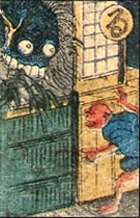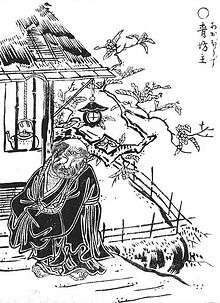Aobōzu
Aobōzu (

In folk legends
In legends, the aobōzu does not have a fixed image or perception in all areas and legends, and is often expressed as a kind of large human figure or large thing shaped like a bōzu (priest). In Minabe, Hidaka District, Wakayama Prefecture, it is said that a large blue aobōzu appeared,[2] while in Kaneyama, Ōnuma District, Fukushima Prefecture, a weasel disguised as an aobōzu[3] and in Gifu Prefecture and Hiroshima Prefecture, a tanuki disguised as an aobōzu were said to have appeared.[4][5] In Haibara District, Shizuoka Prefecture, there is also a story about aobōzu despite not having many details.[6]
Nagano Prefecture
- At a certain pine tree, if one stops breathing and spins around 7 times, it would appear and say "don't trample the rocks, don't snap the pine tree."
- It is said that once, a large koi carp lived as the master of a certain stream pool abyss, and it started putting on a fierce struggle when it was about to be captured by humans, so the villagers planted this tree in order to calm the large koi carp.[7]
Shizuoka Prefecture
- It is said that at sunset time one day in spring, if children who come home late were to run across a wheat field, an aobōzu would appear from the wheat and kidnap that child, which is a reason for not letting children out into the fields at evening in springtime.[8]
Okayama Prefecture
- It is large bōzu yōkai that has a blue body or wears blue clothes. They appear at vacant houses, among other places.[9]
Yamaguchi Prefecture
- They are a mountain god (Yama-no-Kami) who have turned into a small bōzu appearance. They would appear before people and suggest engaging in sumō. They look small, but they are actually a god, so it is said that if one overconfidently tried to take on this challenge, they would toss one in an instant, which could even be life-threatening.[10]
Kagawa Prefecture
- They would appear before women and suggest, "how about hanging your neck?" They would disappear if this was rejected, but if one ignores them without saying anything, the aobōzu would come forcefully and attack the woman to put her unconscious and actually hang her by the neck.[11][12]
In urban legends
Starting in the Shōwa period, urban legends (school horror tales) have been told under the name of aobōzu.
Yamagata Prefecture
- It is said that at the bathroom in a certain elementary school along a mountain, the face of a bōzu (priest) with a blue head would appear from the toilet and stare at you.[13]
Fukushima Prefecture
- Like in Yamagata, in the first half of the Shōwa 10 decade, it is said that an aobōzu would appear in an elementary school bathroom, and it is said that the students at the time were so fearful of it, they couldn't their usual business there.[14]
In the Gazu Hyakki Yagyō

The picture by Sekien depicts what appears to be a one-eyed priest standing next to a thatched hut, but the Gazu Hyakki Yagyō did not come with any explanatory text, so it is unknown exactly what kind of yōkai this is,[9] but it is considered to be based on the mehitotsu-bō depicted Edo Period pictures before Sekien, such as the Hyakkai Zukan by Sawaki Suushi.[15]
There is the idea that "ao" (blue) can refer to immaturity, so perhaps Sekien drew an insufficiently trained priest as a yōkai.[16]
See also
- Gazu Hyakki Yakō
- List of legendary creatures from Japan
References
- Katsumi Tada (1998). Edo Yōkai Karuta (江戸妖怪かるた, Edo Period Ghost Cards) (in Japanese). Kokushokan Kōkai. p. 18. ISBN 978-4-336-04112-8.
- 大嶋一人他編, ed. (1995). "南部川の民俗". 近畿の民俗. 日本民俗調査報告書集成. 和歌山県編. 三一書房. p. 473. ISBN 978-4-380-95551-8.
- "福島県大沼郡金山町 調査報告書". 常民. 中央大学 民俗研究会 (26): 126. February 1990. NCID AN00116782. Retrieved 2010-11-06.
- 河出碩文 (1989). "人魂はある". 美濃民俗. 美濃民俗文化の会 (262): 492. NCID AN00235544. Retrieved 2015-08-26.
- 小笠原俊郎 (1933). "備後の俗信". 旅と伝説. 三元社. 6 (3号(通巻63号)): 75–76. NCID AN00139777. Retrieved 2015-08-26.
- "静岡県榛原郡相良町旧地頭方村". 民俗採訪. 國學院大學 民俗学研究会 (昭和59年度号): 161. October 1985. NCID AN00313874. Retrieved 2010-11-06.
- 下平加賀雄 (May 1965). "大草辺の民話・伝説一". 伊那. 伊那文化研究社. 13 (第5号(通巻444号)): 12–16. NCID AN00015559. Retrieved 2009-01-22.
- 今野圓輔編著 (1981). 日本怪談集 妖怪篇. 現代教養文庫. 社会思想社. p. 38. ISBN 978-4-390-11055-6.
- Kenji Murakami, editor (2000). Yōkai Jiten (妖怪事典). The Mainichi Newspapers Co. pp. 3–4. ISBN 978-4-620-31428-0.
- 松岡利夫 (1957). "山の神信仰 山口県の場合". 伊勢民俗. 伊勢民俗学会. 3 (3・4号): 5. NCID AN10234424. Retrieved 2015-08-27.
- 武田明 (1984). "仲多度郡琴南町美合の妖怪と怪談". 香川の民俗. 香川民俗学会 (41): 4. NCID AA11566406. Retrieved 2015-08-27.
- 武田明 (1985). "海と山の妖怪話". 香川の民俗 (44): 7. Retrieved 2015-08-26.
- 山口敏太郎 (2007). 本当にいる日本の「現代妖怪」図鑑. 笠倉出版社. p. 156. ISBN 978-4-7730-0365-9.
- 松谷みよ子 (1987). 現代民話考. 第二期 II. 立風書房. pp. 99–100.
- Natsuhiko Kyogoku, Katsumi Tada (editors) (2000). Yōkai Zukan (妖怪図巻). Kokushokankokai Inc. pp. 164–165. ISBN 978-4-336-04187-6.CS1 maint: extra text: authors list (link)
- Katsumi Tada (2006). Hyakki Kaidoku (百鬼解読). Kodansha Publications. Kodansha. pp. 87–88. ISBN 978-4-06-275484-2.
